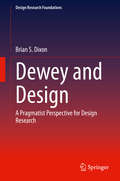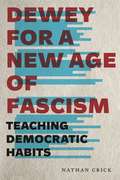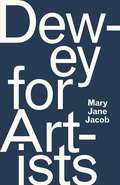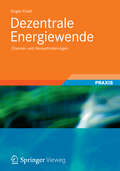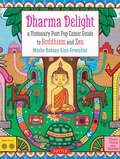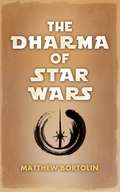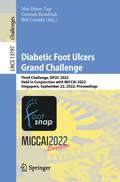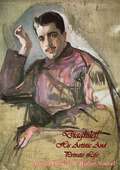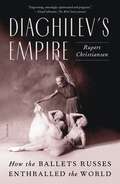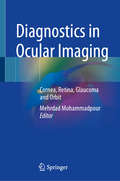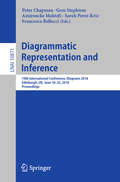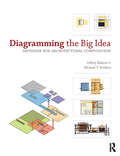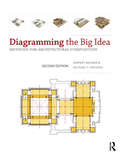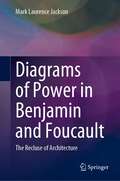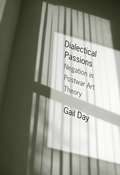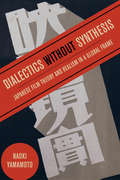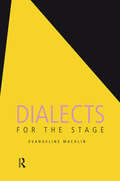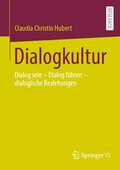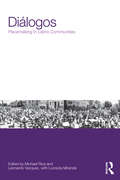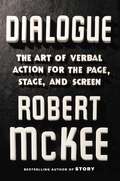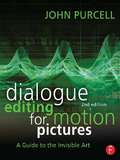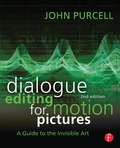- Table View
- List View
Dewey and Design: A Pragmatist Perspective for Design Research (Design Research Foundations)
by Brian S. DixonOver the last four decades, John Dewey’s pragmatist philosophy has formed an intellectual core in design research, underpinning Donald Schön’s theory of reflective practice, the experiential perspective in HCI and the democratic commitments of participatory design. Taking these existing connections as a starting point, Brian Dixon explores how deeper alignments may be drawn between Dewey’s insights and contemporary design research’s concern with practice, meaning and collaboration. Chapter by chapter, a fresh intellectual approach is revealed, one which recognises the transformative power of doing, making and knowing as a force for positive change in the world. We see that, for Dewey, experience comes first. It connects us to surrounding world and the society of which we are part; good things can happen and new realities are possible—we just have to work for them. The implications for design research are vast. We are offered a new way of understanding designerly knowledge production, as well as the methodological implications of adopting Deweyan pragmatism in design research. Taken as a whole, Dewey and Design not only draws out the value of Dewey’s work for design research but also, crucially, offers a clear articulation of the value of design itself.
Dewey for a New Age of Fascism: Teaching Democratic Habits (Rhetoric and Democratic Deliberation #22)
by Nathan CrickDuring the rise of fascism in the early twentieth century, American philosopher and educational reformer John Dewey argued that the greatest threat to democracy was not a political regime or even an aggressive foreign power but rather a set of dispositions or attitudes. Though not fascist in and of themselves, these habits of thought—rugged individualism and ideological nationalism—lay the foundation for fascism. In this study, Nathan Crick uses Dewey’s social thought and philosophy of education to provide insight into and resources for transforming our present-day politics.Through a close reading of Dewey’s political writings and educational theory, Crick elaborates Dewey’s vision of democratic social life and the education required for its foundation. He shows that for Dewey, communication is essential to cultivating sympathy, intelligence, and creativity—habits of thought that form the core of democratic culture. Crick then lays out a broad curriculum of logic, aesthetics, and rhetoric for inculcating these habits in the classroom, arguing that if we are to meet the challenge of fascism, we must teach these new arts as if our civilization depends on it—because in our new age of politics, it does.Comprehensive and pragmatic, this book presents an experimental model of education that can be applied across the humanities curriculum. It will be of interest to teachers of writing, composition, and rhetoric as well as scholars and students of communication studies, pedagogy, and political theory.
Dewey for a New Age of Fascism: Teaching Democratic Habits (Rhetoric and Democratic Deliberation)
by Nathan CrickDuring the rise of fascism in the early twentieth century, American philosopher and educational reformer John Dewey argued that the greatest threat to democracy was not a political regime or even an aggressive foreign power but rather a set of dispositions or attitudes. Though not fascist in and of themselves, these habits of thought—rugged individualism and ideological nationalism—lay the foundation for fascism. In this study, Nathan Crick uses Dewey’s social thought and philosophy of education to provide insight into and resources for transforming our present-day politics.Through a close reading of Dewey’s political writings and educational theory, Crick elaborates Dewey’s vision of democratic social life and the education required for its foundation. He shows that for Dewey, communication is essential to cultivating sympathy, intelligence, and creativity—habits of thought that form the core of democratic culture. Crick then lays out a broad curriculum of logic, aesthetics, and rhetoric for inculcating these habits in the classroom, arguing that if we are to meet the challenge of fascism, we must teach these new arts as if our civilization depends on it—because in our new age of politics, it does.Comprehensive and pragmatic, this book presents an experimental model of education that can be applied across the humanities curriculum. It will be of interest to teachers of writing, composition, and rhetoric as well as scholars and students of communication studies, pedagogy, and political theory.
Dewey for Artists
by Mary Jane JacobJohn Dewey is known as a pragmatic philosopher and progressive architect of American educational reform, but some of his most important contributions came in his thinking about art. Dewey argued that there is strong social value to be found in art, and it is artists who often most challenge our preconceived notions. Dewey for Artists shows us how Dewey advocated for an “art of democracy.” Identifying the audience as co-creator of a work of art by virtue of their experience, he made space for public participation. Moreover, he believed that societies only become—and remain—truly democratic if its citizens embrace democracy itself as a creative act, and in this he advocated for the social participation of artists. Throughout the book, Mary Jane Jacob draws on the experiences of contemporary artists who have modeled Dewey’s principles within their practices. We see how their work springs from deeply held values. We see, too, how carefully considered curatorial practice can address the manifold ways in which aesthetic experience happens and, thus, enable viewers to find greater meaning and purpose. And it is this potential of art for self and social realization, Jacob helps us understand, that further ensures Dewey’s legacy—and the culture we live in.
Dezentrale Energiewende
by Jürgen EiseltDieses Buch ist eine umfassende Bestandsaufnahme für eine bereits angelaufene dezentrale Energiewende. Es wird anhand vorhandener Strukturen, Techniken und wissenschaftlich fundierten Erkenntnissen die Potentiale einer wirkungsvollen Energiewende beschrieben. Ziel dieses Buches ist Darstellung neuer Techniken und efferktiver Konzepte, damit dezentrale Strukturen die zentrale Energieversorgung ablösen. Hauptantrieb für den Einsatz der dezentralen Energieformen sind Kostenreduzierung, energieautarke Systeme bis zur Null-Tarif-Heizung.
Dharma Delight: A Visionary Post Pop Comic Guide to Buddhism and Zen
by Rodney Alan Greenblat Richard ThomasIn Dharma Delight, abstract artist and Zen practitioner Rodney Greenblat uses lighthearted narrative and vivid pop art paintings to celebrate the joys of living life from the inside out.Part graphic guide, part personal testimony, part art book, Dharma Delight illustrates how seeking the path of compassion and acceptance can be as zany and exuberant as it is profound. It is a happy exploration of Buddhist Enlightenment-what it is, where to seek it-and how to recognize the perfection in ourselves. A great option for Zen beginners, sutras (teachings), Bodhisattvas (enlightened beings) and jataka tales (parables) are presented in a way that's simple, upbeat and fun to read.The original paintings-some new, some already known on the New York art scene and elsewhere-are an imaginative and affirming mind's-eye view of Buddhist teaching. Together, the words and illustrations are a warm and cheerful invitation to newcomers and a cool splash of refreshment to any traveler on the road to enlightenment.
The Dharma of Star Wars
by Matthew BortolinPlumbing the Star Wars universe for spiritual lessons is as old as the first Star Wars film released in 1977. The author of this book looks through a specifically Buddhist lens, using Buddhist philosophy to interpret the characters, plots, and dialogue.
The Dharma of The Princess Bride: What the Coolest Fairy Tale of Our Time Can Teach Us About Buddhism and Relationships
by Ethan NichternAn engagingly contemporary approach to Buddhism—through the lens of an iconic film and its memorable charactersHumorous yet spiritually rigorous in the tradition of Zen and the Art of Motorcycle Maintenance and The Tao of Pooh, drawing from pop culture and from personal experience, The Dharma of “The Princess Bride” teaches us how to understand and navigate our most important personal relationships from a twenty-first-century Buddhist perspective.Friendship. Romance. Family. These are the three areas Ethan Nichtern delves into, taking as departure points the indelible characters from Rob Reiner’s perennially popular film—Westley, Fezzik, Vizzini, Count Rugen, Princess Buttercup, and others—as he also draws lessons from his own life and his work as a meditation teacher. Nichtern devotes the first section of the book to exploring the dynamics of friendship. Why do people become friends? What can we learn from the sufferings of Inigo Montoya and Fezzik? Next, he leads us through all the phases of illusion and disillusion we encounter in our romantic pursuits, providing a healthy dose of lightheartedness along the way by sharing his own Princess Buttercup List and the vicissitudes of his dating life as he ponders how we idealize and objectify romantic love. Finally, Nichtern draws upon the demands of his own family history and the film’s character the Grandson to explore the dynamics of “the last frontier of awakening,” a reference to his teacher Chogyam Trungpa’s claim that it’s possible to be enlightened everywhere except around your family. With The Dharma of “The Princess Bride” in hand, we can set out on the path to contemporary Buddhist enlightenment with the most important relationships in our lives.
Diabetic Foot Ulcers Grand Challenge: Third Challenge, DFUC 2022, Held in Conjunction with MICCAI 2022, Singapore, September 22, 2022, Proceedings (Lecture Notes in Computer Science #13797)
by Moi Hoon Yap Connah Kendrick Bill CassidyThis book constitutes the Third Diabetic Foot Ulcers Grand Challenge, DFUC 2022, which was held on September 2022, in conjunction with the 25th International Conference on Medical Image Computing and Computer-Assisted Intervention, MICCAI 2022 in Singapore. The 8 full papers presented together with 5 challenge papers and 3 post-challenge papers included in this book were carefully reviewed and selected from 19 submissions.The DFU challenges aim to motivate the health care domain to share datasets, participate in ground truth annotation, and enable data-innovation in computer algorithm development. In the longer term, it will lead to improved patient care.
Diaghileff: His Artistic And Private Life
by Arnold Haskell Walter NouvelThis is not the story of the Diaghileff Ballet, but of the man himself; and the ballet, though it occupied the greater part of his active life, was but one manifestation of his creative ability...Diaghileff himself was greater than his ballet, and he can only be discovered through a careful study of those early years in Russia."
Diaghilev's Empire: How the Ballets Russes Enthralled the World
by Rupert ChristiansenA Best Book of the Year at The New Yorker and The Telegraph“Amusing and assertive . . . [Christiansen’s] delight is infectious.” —Alexandra Jacobs, The New York Times Book ReviewRupert Christiansen, a renowned dance critic and arts correspondent, presents a sweeping history of the Ballets Russes and of Serge Diaghilev’s dream of bringing Russian art and culture to the West. Serge Diaghilev, the Russian impresario and founder of the Ballets Russes, is often said to have invented modern ballet. An art critic and connoisseur, Diaghilev had no training in dance or choreography, but he had a dream of bringing Russian art, music, design, and expression to the West and a mission to drive a cultural and artistic revolution.Bringing together such legendary talents as Vaslav Nijinsky, Anna Pavlova, Igor Stravinsky, Pablo Picasso, and Henri Matisse, this complex and visionary genius created a new form of ballet defined by artistic integrity, creative freedom, and an all-encompassing experience of art, movement, and music. The explosive color combinations, sensual and androgynous choreography, and experimental sounds of the Ballets Russes were called “barbaric” by the Parisian press, but its radical style usurped the entrenched mores of traditional ballet and transformed the European cultural sphere at large.Diaghilev’s Empire, the publication of which marks the one hundred fiftieth anniversary of Diaghilev’s birth, is a daring, impeccably researched reassessment of the phenomenon of the Ballets Russes and the Russian Revolution in twentieth-century art and culture. Rupert Christiansen, a leading dance critic, explores the fiery conflicts, outsize personalities, and extraordinary artistic innovations that make up this enduring story of triumph and disaster.
Diagnostics in Ocular Imaging: Cornea, Retina, Glaucoma and Orbit
by Mehrdad MohammadpourThis book presents a new avenue in the field of ophthalmology and sheds light on the field of eye imaging. With the increasing availability of electronic devices and their important role in both personal and professional aspects of human life, there is a growing need for perfect vision. Ophthalmic imaging is a major tool for screening and documenting eye diseases in both medical and surgical fields of ophthalmology and is also of use for ophthalmologists around the globe. The number of eye-imaging devices has increased dramatically, however undiagnosed or poorly managed eye diseases remain a significant cause of ocular and visual problems worldwide. This essential guide addresses the need for a book that is dedicated to ophthalmic imaging, covering the cornea, glaucoma, retina and orbital imaging with updates on medical and surgical aspects of the topic.
Diagrammatic Representation and Inference: 10th International Conference, Diagrams 2018, Edinburgh, UK, June 18-22, 2018, Proceedings (Lecture Notes in Computer Science #10871)
by Francesco Bellucci Sarah Perez-Kriz Amirouche Moktefi Gem Stapleton Peter ChapmanThis book constitutes the refereed proceedings of the 10th International Conference on the Theory and Application of Diagrams, Diagrams 2018, held in Edinburgh, UK, in June 2018.The 26 revised full papers and 28 short papers presented together with 32 posters were carefully reviewed and selected from 124 submissions. The papers are organized in the following topical sections: generating and drawing Euler diagrams; diagrams in mathematics; diagram design, principles and classification; reasoning with diagrams; Euler and Venn diagrams; empirical studies and cognition; Peirce and existential graphs; and logic and diagrams.
Diagramming the Big Idea: Methods for Architectural Composition
by Jeffrey Balmer Michael T. SwisherAs a beginning design student, you need to learn to think like a designer, to visualize ideas and concepts, as well as objects. In Diagramming the Big Idea, Jeffrey Balmer and Michael T. Swisher illustrate how you can create and use diagrams to clarify your understanding of both particular projects and organizing principles and ideas. With accessible, step-by-step exercises that interweave diagrams, drawings and virtual models, the authors clearly show you how to compose meaningful and useful diagrams. As you follow the development of the four project groups drawn from the authors’ teaching, you will become familiar with architectural composition concepts such as proportion, site, form, hierarchy and spatial construction. In addition, description and demonstration essays extend concepts to show you more examples of the methods used in the projects. Whether preparing for a desk critique, or any time when a fundamental insight can help to resolve a design problem, this book is your essential studio resource.
Diagramming the Big Idea: Methods for Architectural Composition
by Jeffrey Balmer Michael T. SwisherBecoming an architect is a daunting task. Beyond the acquisition of new skills and procedures, beginning designers face an entirely unfamiliar mode of knowledge: design thinking. In Diagramming the Big Idea, Jeffrey Balmer and Michael T. Swisher introduce the fundamentals of design thinking by illustrating how architects make and use diagrams to clarify their understanding of both specific architectural projects and universal principles of form and order. With accessible, step-by-step procedures that interweave diagrams, drawings and virtual models, the authors demonstrate how to compose clear and revealing diagrams. Design thinking defines a method for engaging the world through observation and analysis. Beyond problem solving, design is a search for possibilities. Mastering design thinking begins with learning the fundamentals of visual composition. It embraces the ability to synthesize deductive and imaginative reasoning, combining both shrewd scrutiny and fevered speculation. Design diagrams make visible the abstractions that order the built environment. Premised upon the Beaux-Arts notion of the architectural parti, Balmer and Swisher adopt the ‘Big Idea’ as a foil and as a suitcase to organize fundamentals of architectural composition. The goal of this book is to make explicit to students what they are learning, why they are learning it and how to internalize such lessons toward their lifelong development as designers.
Diagrams of Power in Benjamin and Foucault: The Recluse of Architecture
by Mark Laurence JacksonThis book’s overarching premise is that discussion and critique in the discourses of architecture and urbanism have their primary focus on engagements with form, particularly in the sense of the question as to what planning and architecture signify with respect to the forms they take, and how their meanings or content (what is “contained”) is considered in relation to form-as-container. While significant critical work in these disciplines has been published over the past 20 years that engages pertinently with the writings of Walter Benjamin and Michel Foucault, there has been no address to the co-incidence in the work of Benjamin and Foucault of an architectural figure that is pivotal to each of their discussions of the emergence of modernity: The arcade for Benjamin and the panoptic prison for Foucault have a parallel role. In Foucault’s terms, panopticism is a “diagram of power.” The parallel, for Benjamin, would be his understanding of “constellation.” In more recent architectural writings, the notion of the diagram has emerged as a key motif. Yet, and in as much as it supposedly relates to aspects of the work of Foucault, along with Gilles Deleuze, this notion of “diagram” amounts, for the most part, to a thinly veiled reinstatement of geometry-as-idea. This book redresses the emphasis given to form within the cultural philosophy of modernity and—particularly with respect to architecture and urbanism—inflects on the agency of force that opens a reading of their productive capacities as technologies of power. It is relevant to students and scholars in poststructuralist critical theory, architecture, and urban studies.“This is a book about Foucault and Benjamin and it is grounded in a deep knowledge of and reflection upon their works, but it is also underpinned by an impressive erudition. There are reflections on Hegel and Heidegger (central to the author) and Derrida, along with Kierkegaard, and others. This leads to a rich and suggestive discussion … in staging a spatial-architectural-political conversation between Foucault and Benjamin.”- Anonymous Reviewer“Mark Jackson’s Diagrams of Power in Benjamin and Foucault, The Recluse of Architecture juxtaposes and interrogates its two leading actors so as to draw from and through them a theory of architecture, which is inseparable from its recluse. In doing so it elaborates a series of complex connections with their various interlocutors and inspirations, Hegel, Heidegger, Derrida, the Kabbalah, Agamben, allegory, Marx, Deleuze, Klossowski, tragedy, capitalism, modernity, and so on. The list is long and impressive. This is not only done with an extremely high degree of scholarship, but is presented in a light, lucid and very compelling manner in a voice both personal and authoritative. The recluse is the figure of mimesis itself, the appearance of a withdrawal, always already a ruin. This book not only contributes a highly astute reading of its philosophical objects, but it enacts the ontology of the recluse through its own unfolding, simultaneously revealing and withholding the meaning of architecture ‘as such’, so that we not only understand its meaning, but feel the pulsing differential of the book’s object as if it were alive within us.”- Stephen Zepke, Independent Researcher, Vienna
Dialectical Passions: Negation in Postwar Art Theory (Columbia Themes in Philosophy, Social Criticism, and the Arts)
by Gail DayRepresenting a new generation of theorists reaffirming the radical dimensions of art, Gail Day launches a bold critique of late twentieth-century art theory and its often reductive analysis of cultural objects. Exploring core debates in discourses on art, from the New Left to theories of "critical postmodernism" and beyond, Day counters the belief that recent tendencies in art fail to be adequately critical. She also challenges the political inertia that results from these conclusions.Day organizes her defense around critics who have engaged substantively with emancipatory thought and social process: T. J. Clark, Manfredo Tafuri, Fredric Jameson, Benjamin H. D. Buchloh, and Hal Foster, among others. She maps the tension between radical dialectics and left nihilism and assesses the interpretation and internalization of negation in art theory. Chapters confront the claim that exchange and equivalence have subsumed the use value of cultural objects-and with it critical distance- and interrogate the proposition of completed nihilism and the metropolis put forward in the politics of Italian operaismo. Day covers the debates on symbol and allegory waged within the context of 1980s art and their relation to the writings of Walter Benjamin and Paul de Man. She also examines common conceptions of mediation, totality, negation, and the politics of anticipation. A necessary unsettling of received wisdoms, Dialectical Passions recasts emancipatory reflection in aesthetics, art, and architecture.
Dialectical Passions: Negation in Postwar Art Theory
by Gail DayRepresenting a new generation of theorists who reaffirm the radical dimensions of art, Gail Day launches a bold critique of late-twentieth-century art theory and its often reductive analysis of cultural objects. Exploring core debates in discourses on art, from the New Left to theories of "critical postmodernism" and beyond, Day counters the belief that recent tendencies in art fail to be adequately critical and challenges the political inertia that results from these conclusions. Day organizes her defense around critics who have engaged substantively with emancipatory thought and social process: T. J. Clark, Manfredo Tafuri, Fredric Jameson, Benjamin H. D. Buchloh, and Hal Foster, among others. She maps the tension between radical dialectics and left nihilism and assesses the interpretation and internalization of negation in art theory. Chapters confront the claim that exchange and equivalence have subsumed the use value of cultural objects& mdash;and with it critical distance; the meaning of symbol and allegory in 1980s art and its limited reading of the writings of Walter Benjamin and Paul de Man; and common conceptions of mediation, totality, and the politics of anticipation. A necessary unsettling of received wisdoms, Dialectical Passions sets a new course for emancipatory reflection in aesthetics, art, and architecture.
Dialectics without Synthesis: Japanese Film Theory and Realism in a Global Frame
by Naoki YamamotoDialectics without Synthesis explores Japan’s active but previously unrecognized participation in the global circulation of film theory during the first half of the twentieth century. Examining a variety of Japanese theorists working in the fields of film, literature, avant-garde art, Marxism, and philosophy, Naoki Yamamoto offers a new approach to cinematic realism as culturally conditioned articulations of the shifting relationship of film to the experience of modernity. In this study, long-held oppositions between realism and modernism, universalism and particularism, and most notably, the West and the non-West are challenged through a radical reconfiguration of the geopolitics of knowledge production and consumption.
Dialects for the Stage
by Evangeline MachlinDialect work is one of the actor's most challenging tasks. Need to know a Russian accent? Playing a German countess or a Midwestern farmhand? These and more accents – from Yiddish to French Canadian – are clearly explained in Evangeline Machlin's classic work. Now available in a book-and-CD format, Evangeline Machlin's Dialects for the Stage is based on a method of dialect acquisition she developed during her years working with students at Boston University's Division of Theatre. During her long career, Evangeline Machlin trained such actors as Steve McQueen, Lee Grant, Suzanne Pleshette, Joanne Woodward, and Faye Dunaway.
Dialogkultur: Dialog sein – Dialog führen – dialogische Beziehungen
by Claudia Christin HubertDialog ist ein Wort, mit dem jeder etwas anfangen kann. Doch wann führen wir einen Dialog? Wie kann eine oft geforderte Dialogkultur beschrieben werden? Dieses Buch gibt durch die kategoriegeleitete Analyse verschiedenster Theorien und Dialogkonzepten eine Antwort auf diese Fragen. Dabei werden Ansätze der Philosophie genauso betrachtet wie jene der Organisationssoziologie, der Kommunikationswissenschaften, der Soziologie, der Psychologie oder der Theologie - von Martin Buber über Marshall Rosenberg und Schulz von Thun bis hin zu Pierpaolo Donati, Carl Rogers und Papst Franziskus. Dabei werden die Gemeinsamkeiten der Ansätze ebenso dargestellt, wie die jeweiligen Spezifika. Es werden nicht nur die Handlungsweisen beschrieben, welche einen Dialog ausmachen, sondern auch die dahinterstehenden Annahmen über den Dialog, das zugrundeliegende Menschenbild, Werte und Normen. So bietet das Buch einen guten Überblick über die Dialogkultur und einen guten Einstieg in die Thematik.
Diálogos: Placemaking in Latino Communities
by Michael Rios Leonardo Vazquez Lucrezia MirandaLatinos are one of the largest and fastest growing social groups in the United States, and their increased presence is profoundly shaping the character of urban, suburban, and rural places. This is a response to these developments and is the first book written for readers seeking to learn about, engage and plan with Latino communities. It considers how placemaking in marginalized communities sheds light on, and can inform, community-building practices of professionals and place dwellers alike. Diálogos: Placemaking in Latino Communities will help readers better understand the conflicts and challenges inherent in placemaking, and to make effective and sustainable choices for practice in an increasingly multi-ethnic world. The essays explore three aspects of place: the appropriation and territorialization of the built environment, the claiming of rights through collective action, and a sense of belonging through civic participation. The authors illustrate their ideas through case studies and explain the implications of their work for placemaking practice. A consistent theme about planning and design practice in Latino communities emerges throughout the book: placemaking happens with or without professional planners and designers. All of the essays in Diálogos demonstrate the need to not only imagine, build, and make places with local communities, but also to re-imagine how we practice democracy inclusive of cross-cultural exchange, understanding, and respect. This will require educators, students, and working professionals to incorporate the knowledge and skills of cultural competency into their everyday practices.
Dialogue: The Art of Verbal Action for Page, Stage, and Screen
by Robert MckeeThe long-awaited follow-up to the perennially bestselling writers' guide Story, from the most sought-after expert in the art of storytelling. Robert McKee's popular writing workshops have earned him an international reputation. The list of alumni with Oscars runs off the page. The cornerstone of his program is his singular book, Story, which has defined how we talk about the art of story creation. Now, in DIALOGUE, McKee offers the same in-depth analysis for how characters speak on the screen, on the stage, and on the page in believable and engaging ways. From Macbeth to Breaking Bad, McKee deconstructs key scenes to illustrate the strategies and techniques of dialogue. DIALOGUE applies a framework of incisive thinking to instruct the prospective writer on how to craft artful, impactful speech. Famous McKee alumni include Peter Jackson, Jane Campion, Geoffrey Rush, Paul Haggis, the writing team for Pixar, and many others.
Dialogue Editing for Motion Pictures: A Guide to the Invisible Art
by John PurcellProduce professional level dialogue tracks with industry-proven techniques and insights from an Emmy Award winning sound editor. Gain innovative solutions to common dialogue editing challenges such as room tone balancing, noise removal, perspective control, finding and using alternative takes, and even time management and postproduction politics. In Dialogue Editing for Motion Pictures, Second Edition veteran film sound editor John Purcell arms you with classic as well as cutting-edge practices to effectively edit dialogue for film, TV, and video. This new edition offers: A fresh look at production workflows, from celluloid to Digital Cinema, to help you streamline your editing Expanded sections on new software tools, workstations, and dialogue mixing, including mixing "in the box" Fresh approaches to working with digital video and to moving projects from one workstation to another An insider’s analysis of what happens on the set, and how that affects the dialogue editor Discussions about the interweaving histories of film sound technology and film storytelling Eye-opening tips, tricks, and insights from film professionals around the globe A companion website (www.focalpress.com/cw/purcell) with project files and video examples demonstrating editing techniques discussed in the book Don’t allow your dialogue to become messy, distracting, and uncinematic! Do dialogue right with John Purcell’s all-inclusive guide to this essential yet invisible art.
Dialogue Editing for Motion Pictures: A Guide to the Invisible Art (Second Edition)
by John PurcellIn Dialogue Editing for Motion Pictures, Second Edition, John Purcell arms you with classic as well as cutting-edge practices to effectively edit dialogue for film, TV, and video.
